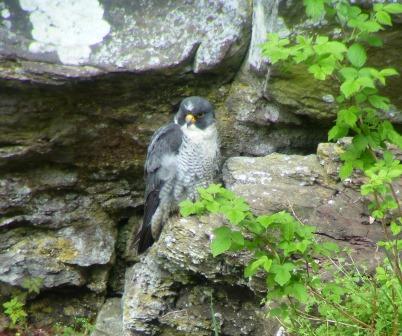Intern Diary Week 9 – Peregrine population status
I apologize for the tardiness of the post as this was supposed to have been published last week. However after writing my draft I completely forgot to post it so here it is.
It was a great weekend here at the Peregrine Watch! With a sunny Saturday and lazy peregrines we had great views of our pair.
They spent most of the time sitting around but kept showing mating behaviour and brought in prey almost every day. Because it was a bit quieter we had time to have great conversations with visitors from all over the world. I love when we can do that as it is my favourite part of working with the public!

Now that our peregrines are showing signs of being done with their contribution to population number increase, I have been doing a bit of reading about Peregrine Falcon populations and their conservation status.
On a global scale, peregrines are classified as Least Concern by the IUCN in the Red List of Threatened Species. This status is due to their vast distribution (in every continent except Antarctica) and large, stable population estimated at 1200000 in 2004. However, because the species is so widespread, a favourable global conservation status doesn’t mean they are doing well in Scotland, so I dug a little deeper.
In the UK there was a major population decline in the 19th and 20th century mainly because of illegal killing and the accumulation of persistent agricultural chemicals (like DDT) in the food chain. A census of peregrine breeding pairs conducted by the BTO, JNCC, RSPB and Raptor Study Groups every 10 years has revealed some good news for the most part: in the late 1990s numbers had increased to pre-DDT levels in the UK and there has been a slow steady increase since. The last figure, obtained in 2002, was of 1400 breeding pairs, 10% more than in 1991. Of these 544 are found in Scotland.
So overall those are good news! Areas like the southwest, southeast, northeast, Orkney and the Western Isles have shown increases to different degrees; unfortunately Argyll and the Highlands are suffering a decrease and there are no peregrines in the Shetland Islands.
What really matters though is that you’ll always be able to see them from one of the best viewpoints in the UK here at the Falls of Clyde 🙂
Hope to see you soon
Cat Fonseca – Scottish Wildlife Trust, Peregrine Ranger Intern
Help support our vital work and join us today!
Help protect Scotland’s wildlife
Our work to save Scotland’s wildlife is made possible thanks to the generosity of our members and supporters.
Join today from just £3 a month to help protect the species you love.
Preface
I apologize for the tardiness of the post as this was supposed to have been published last week. However after writing my draft I completely forgot to post it so …
